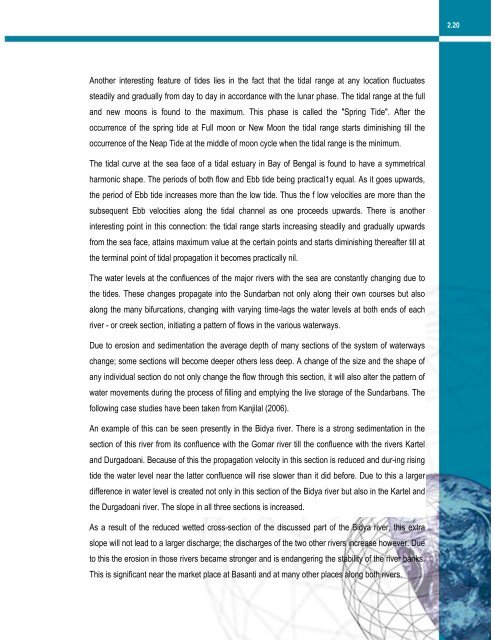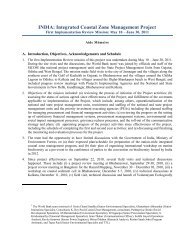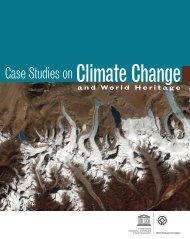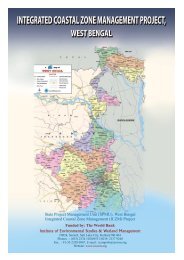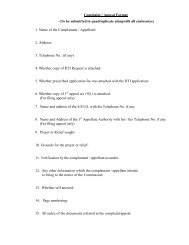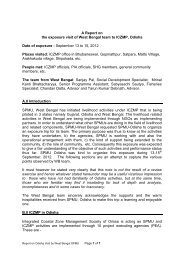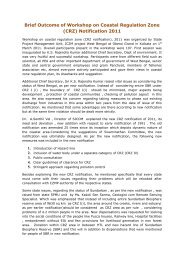Cyclone and Storm Surge - Iczmpwb.org
Cyclone and Storm Surge - Iczmpwb.org
Cyclone and Storm Surge - Iczmpwb.org
Create successful ePaper yourself
Turn your PDF publications into a flip-book with our unique Google optimized e-Paper software.
2.20<br />
Another interesting feature of tides lies in the fact that the tidal range at any location fluctuates<br />
steadily <strong>and</strong> gradually from day to day in accordance with the lunar phase. The tidal range at the full<br />
<strong>and</strong> new moons is found to the maximum. This phase is called the "Spring Tide". After the<br />
occurrence of the spring tide at Full moon or New Moon the tidal range starts diminishing till the<br />
occurrence of the Neap Tide at the middle of moon cycle when the tidal range is the minimum.<br />
The tidal curve at the sea face of a tidal estuary in Bay of Bengal is found to have a symmetrical<br />
harmonic shape. The periods of both flow <strong>and</strong> Ebb tide being practical1y equal. As it goes upwards,<br />
the period of Ebb tide increases more than the low tide. Thus the f low velocities are more than the<br />
subsequent Ebb velocities along the tidal channel as one proceeds upwards. There is another<br />
interesting point in this connection: the tidal range starts increasing steadily <strong>and</strong> gradually upwards<br />
from the sea face, attains maximum value at the certain points <strong>and</strong> starts diminishing thereafter till at<br />
the terminal point of tidal propagation it becomes practically nil.<br />
The water levels at the confluences of the major rivers with the sea are constantly changing due to<br />
the tides. These changes propagate into the Sundarban not only along their own courses but also<br />
along the many bifurcations, changing with varying time-lags the water levels at both ends of each<br />
river - or creek section, initiating a pattern of flows in the various waterways.<br />
Due to erosion <strong>and</strong> sedimentation the average depth of many sections of the system of waterways<br />
change; some sections will become deeper others less deep. A change of the size <strong>and</strong> the shape of<br />
any individual section do not only change the flow through this section, it will also alter the pattern of<br />
water movements during the process of filling <strong>and</strong> emptying the live storage of the Sundarbans. The<br />
following case studies have been taken from Kanjilal (2006).<br />
An example of this can be seen presently in the Bidya river. There is a strong sedimentation in the<br />
section of this river from its confluence with the Gomar river till the confluence with the rivers Kartel<br />
<strong>and</strong> Durgadoani. Because of this the propagation velocity in this section is reduced <strong>and</strong> dur-ing rising<br />
tide the water level near the latter confluence will rise slower than it did before. Due to this a larger<br />
difference in water level is created not only in this section of the Bidya river but also in the Kartel <strong>and</strong><br />
the Durgadoani river. The slope in all three sections is increased.<br />
As a result of the reduced wetted cross-section of the discussed part of the Bidya river, this extra<br />
slope will not lead to a larger discharge; the discharges of the two other rivers increase however. Due<br />
to this the erosion in those rivers became stronger <strong>and</strong> is endangering the stability of the river banks.<br />
This is significant near the market place at Basanti <strong>and</strong> at many other places along both rivers.


